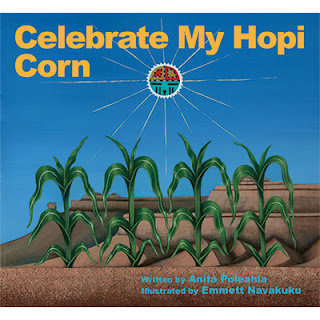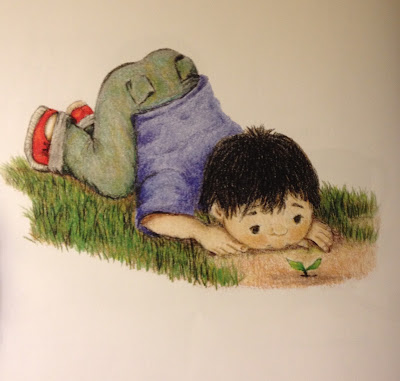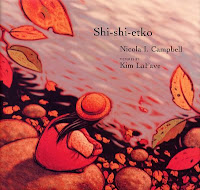My grandfather, Rex Sotero Calvert, was Hopi. We never called him grandpa or grandfather. We called him Thehtay, which is the Tewa word for grandfather (Tewa is our language at Nambe Pueblo). Calvert is the name he was given when he went to boarding school, at Santa Fe Indian School. Before that, he was Rex Sotero Sakiestewa. He was born in 1895 at Mishongnovi Village.
At SFIS, he met my grandmother, Emilia Martinez. She was from Ohkay Owingeh (San Juan Pueblo). They lived at Ohkay Owingeh and had six children: Delfino, Francis, Marcelino, Edward, Andrea, and Cecilia. To me, they were Uncle Del, Uncle Francis, Uncle Mars, and Aunt Cecilia. Edward--we call him Uncle John. He still lives there, at Ohkay Owingeh. Andrea--we call her mom.
When I talk with my mom, we sometimes talk about Thehtay. He lived with us at Nambe Pueblo when I was growing up. I remember him being out back, working the garden with a hoe... Suddenly he'd yell "The beans!" We'd have been playing in the garden as he worked, no doubt un-doing the work he'd been doing to irrigate that garden as we made little dams to divert the irrigation water! Remembering the beans, he'd throw down the hoe and run inside the house to add water to the pot of beans on the stove. When he was older, he'd sit in his wheelchair, softly singing Hopi songs to himself. I wish I'd listened to them, and that I'd learned some of them. What I do have are warm memories of him, of being with him, of his humor.
This morning as I read My Hopi Corn and My Hopi Toys, my thoughts, understandably, turned to Thehtay. Written by Anita Poleahla and illustrated by Emmett Navakuku, the two are board books from Salina Press.

Celebrate My Hopi Corn begins with a single corn kernel telling the reader that she has many sister kernels on an ear of corn, that they grow under a warm sun, and that as the days begin to shorten, the kernels take on different colors. Some are yellow, while others are blue or red or white. After they're harvested, the kernels are shelled off the cobs. For that, we're shown a Hopi girl in traditional clothes shelling the kernels off the cobs. Some kernels are ground into flour to make piki (a traditional food that is exquisite in form and flavor. In form it looks like a rolled up newspaper, with the paper itself being the piki, which is kind of like filo dough in its flakey texture). Some corn is used for dances, and, some is kept inside for the next planting season, when a Hopi man plants corn. That page, especially, made me think of Thehtay:

I don't have a memory of Thehtay planting seeds. My memory is of him in a button down shirt and jeans (nothing on his head; not wearing a belt or mocs as shown in the illustration) using a hoe to rid the garden of weeds.
As you see by the illustration, the text in
Celebrate My Hopi Corn is in two languages: Hopi, and English. The illustrations are a blend of realistic depictions of people, and, Hopi images like the one of the sun, and later, one of rain clouds. The book ends with a double paged spread of corn maidens:
Corn. Community. Ceremony. Planting. All are important to who the Hopi people are. I really like this little book and wish I could share it with Thehtay. Poleahla and Navakuku's second book,
Celebrate My Hopi Toys is a counting book of items used for play, but also for dance. I like it very much, too. Like
Celebrate My Hopi Corn, it is bilingual and shows items specific to Hopi people. Poleahla has been working on language instruction for many years. These little books will, no doubt, be much loved by Hopi children, but they're terrific for any child. For children who aren't Hopi, they provide a window to Hopi culture. A window--I will also note--that is provided by insiders who know just what can be shared with everyone.
They are available from
Salina Press.
I am happy to recommend The Apple Tree by Sandy Tharpe-Thee and Marlena Campbell Hodson. Published this year by Road Runner Press, the story is about Cherokee boy who plants an apple seed in his backyard.
Here's the cover:
Here's the little boy:
And here's the facing page for the one of the little boy:
I like this anthropomorphized story very much and think it is an excellent book all on its own, and would also be terrific for read-aloud sessions when introducing kids to stories about planting, or patience, or... apples!
When the apple tree sprouts and is a few inches high, the little boy puts a sign by it so that people will see it and not accidentally step on it. That reminds me of my grandmother. She did something similar. To protect a new cedar tree that sprouted near a roadside on the reservation, she make a ring of stones around it so people wouldn't run over it. The apple tree in Tharp-Thee's story grows, as does the boy, and eventually the tree produces apples.
When you read it, make sure you show kids the Cherokee words, and show them the Cherokee Nation's website, too. Help your students know all they can about the Cherokee people. Published in 2015 by The Road Runner Press. The author, Sandy Tharpe-Thee, is a tribal librarian and received the
White House Champion of Change award for her work. She is an enrolled member of the Cherokee Nation.
Yowls? Chant? Wail?!! This is a wild guess, but I wonder...
When they were kids, did Dina Capiello of the Associated Press, Andrew Kirell of Mediaite, and the nameless person who posted a video at CNN read children's books like Little House on the Prairie that told them that Native people "yowl" or "chant" or "wail"?!
While any person might do any of those things for one reason or another, those words are not what took place in the Senate Gallery yesterday. Something happened when the Senate voted down the Keystone pipeline bill.
Greg Grey Cloud sang a song.
Grey Cloud is an enrolled member of the Crow Creek Sioux Tribe and co-founder of Wica Agli, an organization dedicated to helping men and boys create communities that value self, family, and community. That work includes protesting the Keystone pipeline, and that is why Greg Grey Cloud was in the Senate gallery yesterday. The bill being voted down marked a victory for the protest work he and Native people have been doing.
So Greg Grey Cloud sang a song, but the three news media I noted at the top of this post didn't call it a song. The first news source I read about the vote was Mediaite. Initially, their headline was "Native American Chant Interrupts Senate as Keystone Vote Fails." The word "chant" bothered me and I set about to create a graphic that corrected the use of "chant." As I did that, a colleague said it was a Victory song, so I added that to the correction I made. This is what I came up with (it needed another correction, as you'll see later):

This morning, I saw that CNN called it wailing:
And, I saw that the AP reporter used "yowls" in the final paragraph of her report:
In getting this blog post ready, I went back to the Mediate article and saw that they had changed the wording in their headline. The new one is on the left. My edited one is on the right. I am glad they changed their headline, and I imagine that those involved in that change will not make that mistake again!
As it turns out, my corrections needed a correction, too! In an
interview today, Grey Cloud said he was overcome with joy at the outcome of the vote:
I looked down and thought we need to honor these Senators for having the courage to make the right decision, for not only Indian country but for America as a whole. As a singer, I know only one way to honor someone, and that’s to sing. I didn’t mean to disrupt the Senate, only to honor the conviction shown by the Senators.
Grey Cloud was singing in his language. Here's the Lakota words, and the English translation:
Lakota language for Unci Maka Olowan song: “Tunkasila wamayanka yo, le miye ca tehiya nawazin yelo. unci maka nawacincina wowahwala wa yuha waun welo”
English translation Grandmother Earth song: “Grandfather look at me, I am standing here struggling, I am defending grandmother earth and I am chasing peace.”
And here's the video of that moment in the Senate:
Though that language and style of singing may be unfamiliar to most people, the words in the song are ones spoken by a people who is Indigenous to this land, and whose culture has been misrepresented and marginalized so much that those three reporters, and perhaps most of the people there, did not recognize it for what it is.
That has to change. That means replacing books that misrepresent Native peoples with books that don't have problems of misrepresentation. Please let go of those classics. They have not served us well. Choose, instead, books that present all peoples as people. Start with the books on AICL's
Best Books list.
Several times on
American Indians in Children's Literature, I've written about Nicola Campbell's outstanding picture book about a little girl going to boarding school,
Shi-shi-etko. An award-winning book,
Shi-shi-etko was made into an award-winning
short film that is available from Moving Images Distribution for $40.
As you'll see, there are English subtitles in the film. Throughout the film, the language you hear is Halq'emalem, which is the language of the Sto:lo people of the
Sto:lo Nation in British Columbia. Across the US and Canada, Native Nations are using films like
Shi-shi-etko, and newer technologies (the Internet and Apple products) to teach their languages. Through
First Voices, there is an iPod and iPad app for Halq'emalem, available at no charge through iTunes. Preview the Halq'emalem app
here.
Here's the trailer:
I highly recommend that you order a copy of Campbell's
Shi-shi-etko today, and order the video, too.
CM Magazine review of Shi-shi-etko
Today is Indigenous Peoples Day. If you're interested in bringing a Native language into your classroom, library, home, or office, order a wall clock from the Indigenous Language Institute. Yesterday I posted a photo of my wall clock, with Tewa words in the place of numbers.
The Institute has clocks available in the languages listed below, but will work with you to get one in your language:
- Anishnabemowin
- Anishinaabemowin—Michigan
- Chickasaw
- Chinuk-Wawa
- Chemehuevi
- Comanche
- Diné
- Hopi
- Kanien’kéha
- Keres
- Kiowa
- Lakota
- Luiseño
- Lushootseed
- Maliseet
- Māori
- Mi'kmak
- Mikasuki/Seminole Tribe of FL
- Nimipu Nez Perce
- Nomlaki
- Okanagan
- Oneida
- Passamaquoddy
- Penobscot
- Potawatomi
- Sauk
- Seneca
- Tewa
- (Northern) Tewa
- (Northern) Tiwa
- Tolowa
- Umoⁿhoⁿ
- Ute Mountain Ute
- Yup’ik














It's so good to know that there's a video of this book!!